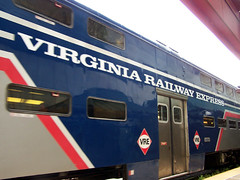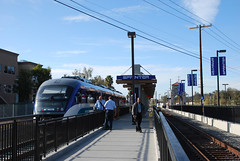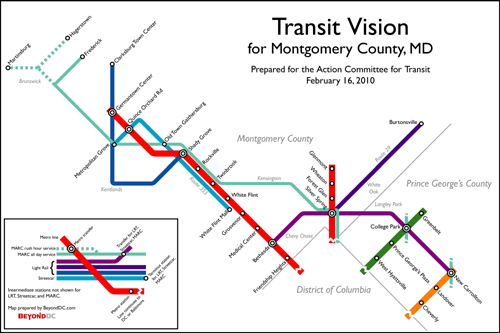|

A VRE train. Most things are the same. |
VRE has officially changed operators. Today marked the first day of service run by a company called Keolis, rather than by historic operator Amtrak. The change in contractor saves VRE money.
For this first week of Keolis service, everything is the same as it was under Amtrak, but starting next week there will be some changes.
The most noteworthy change is that since Amtrak no longer runs VRE, VRE tickets will no longer be accepted on Amtrak trains (correction: only applies to certain Amtrak trains – see comments for more details). Amtrak will still run its Virginia intercity trains of course, and will continue to stop at the same stations, but you’ll need an actual Amtrak ticket to ride. One new VRE train is being added to the Fredericksburg line to compensate, but it’s still a loss.
Otherwise, the changes are fairly minor. Several train schedules are being shifted between 1-5 minutes, and several Fredericksburg trains are being re-numbered.
Average Rating: 4.4 out of 5 based on 243 user reviews.
July 12th, 2010 | Permalink
Tags: commuterrail, galleries, transportation
|

The diesel light rail in Oceanside, CA is a dramatically different type of train than DC Streetcars. |
In the ongoing debate about streetcar wires, some people have suggested that DDOT abandon electric systems altogether and use diesel. After all, if New Jersey can run a diesel light rail operation, why can’t we?
Valid question, but there’s an equally valid answer: Diesel trains are slow to start and stop. Very slow. Anyone who’s ever ridden VRE or MARC’s Brunswick line can attest. They are good for long-distance trains that stop infrequently, but less ideal for any system with frequent stations. The acceleration and deceleration times slow down the trip too much for all riders, and mean trains can’t keep up with car traffic moving along city streets. Remember that trains are a lot heavier than buses; it takes more gas to move them.
New Jersey’s RiverLine diesel light rail is 34 miles long, with 20 stations. That averages to more than a mile and a half between stops. California’s Sprinter diesel light rail is about the same, with 15 stops in 22 miles. Both those routes serve inter-city travel; they are hybrid systems with as much in common to commuter rail as traditional light rail. DC’s streetcar lines are an entirely different animal. Our 8 lines will average less than 5 miles long each, and they’ll have multiple stops per mile. Diesel just isn’t a viable option, unless all others fail.
So yes, there are some trains in the country that use diesel successfully, but these trains are dramatically different from what DC is building, and if you want your trip along H Street to take less than an hour, DDOT needs an electric solution.
Average Rating: 4.4 out of 5 based on 202 user reviews.
April 12th, 2010 | Permalink
Tags: commuterrail, lightrail, streetcar, transportation
Last July, Montgomery County’s Action Committee for Transit worked with Greater Greater Washington to produce a transit vision for the I-270 corridor. Rather than spending billions of dollars on widening I-270 as the State of Maryland proposes, ACT and GGW argued that it would be better and more affordable to invest in a vigorous integrated transit network.
That was all well and good. BeyondDC agrees. But why stop with the I-270 corridor? There’s more to Montgomery County than Gaithersburg.
That in mind, ACT asked me to produce for them the following map, which expands their original 270 vision to encompass the entirety of Montgomery County.

ACT vision for Montgomery County. Click the map to enlarge.
The proposal includes:
- Extension of the Metrorail Red Line from Shady Grove north along I-370 and I-270 to MD Route 118, where it would end at Germantown Town Center. There would be one intermediate station at Quince Orchard Road, where the line crosses the CSX rail tracks.
- MARC improvements resulting in more frequent, all-day, bi-directional service to Frederick.
- A new spur of the MARC Martinsburg branch to reach Hagerstown.
- The completed Corridor Cities Transitway as light rail, with slight modifications to the route at Crown Farm and Kentlands, and a one-station extension to Clarksburg Town Center.
- The completed Purple Line, using the adopted Locally Preferred Alternative alignment.
- A new light rail line beginning at Silver Spring Metro and extending north along US-29 to Burtonsville.
- A new streetcar line beginning at White Flint Mall and running north along MD Route 355 through Rockville and Gaithersburg, ending at an expanded multi-modal Metropolitan Grove station.
- (Not shown on the map) Various bus priority and/or BRT improvements throughout the county, such as on Veirs Mill Road.
For more about their vision for Montgomery County, visit ACTfortransit.org.
Cross-posted at Greater Greater Washington.
Average Rating: 4.5 out of 5 based on 207 user reviews.
February 16th, 2010 | Permalink
Tags: commuterrail, lightrail, metrorail, proposal, roads/cars, streetcar, transportation
















